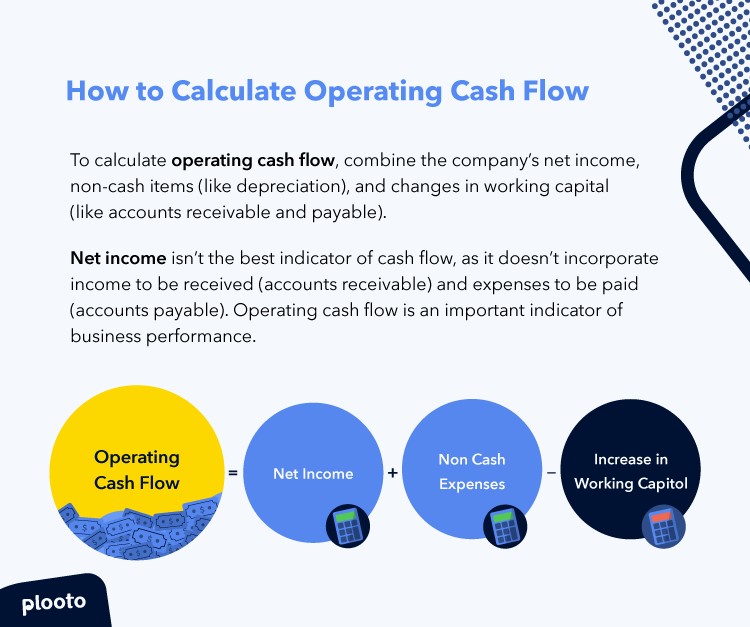
In our previous blog, we covered the fundamentals of cash flow projections and how you can use those to create long-term strategies for your business. However, there are numerous types of cash flows that provide insight into the financial health of your business. Some of these include Investing cash flow, financing cash flow, free cash flow, and operating cash flow (OCF).
In this article, we’ll be diving deeper into operating cash flow and how you can use OCF to help your business manage its finances.
Sign up for a Free Trial today
SHORTCUTS
• Understanding operating cash flow (OCF)
• 3 components of operating activities
• How to calculate operating cash flow
• How to present operating cash flow
• Operating cash flow vs. free cash flow
• Operating cash flow vs. net income
• What is a good operating cash flow ratio?
• What does operating cash flow tell you about your business?
• Startups and operating cash flow
• Growth-stage businesses and cash flow
• Later-stage businesses and cash flow
• Operating cash flow is a good marker for all businesses
• How Plooto can help you with your operating cash flow
Let’s start with what operating cash flow is and the methods by which it is calculated.
Understanding operating cash flow (OCF)
Operating cash flow— is also referred to as cash flow from operating activities.
Operating cash flow is the amount of cash a business earns during regular day-to-day operations in a specific time period. OCF does not include any cash from investing or financing activities.

There are two main ways that OCF is calculated, the indirect method and the direct method. Let's dive into the differences between the two.
Indirect method
Using this method, you must account for only a few key numbers these include net income, depreciation & amortization, and an increase in net working capital.
Direct method
Using this method, you must account for a grouping of cash receipts and payments which include salaries paid to employees, cash paid to vendors and suppliers, income taxes paid, interest paid to lenders, cash collected from customers, interest income and dividends received.
The direct method requires more time and is considered more difficult to implement in comparison to the indirect method. Many accountants and companies often avoid using it and use the indirect method instead.
Now that we’ve gone over a basic overview of OCF and the methods in which it is calculated, let’s go deeper into how operating activities are categorized and a few examples of each category.
3 components of operating activities
Generating revenue
In our operating cashflow statement, revenue comes from daily operations which include the core revenue from sales of goods and services.
Paying expenses
In our operating cashflow statement, expenses come from daily operations that include all cash paid for operating expenses.
Funding working capital
In our operating cashflow statement, working capital comes from calculating the difference between the organization’s current assets and liabilities.

How to calculate operating cash flow
As there are two methods to calculate operating cash flow there can be simple and more complex formulas to calculate OCF. Below you can see two basic formulas:
- Operating Cash Flow = total cash received for sales - cash paid for operating expenses
- Operating Cash Flow = Net Income + Non-Cash Expenses – Increase in Working Capital
Now let’s go into how OCF works with some specific numbers. Below you can see a basic OCF example.
Operating cash flow example

One concept that confuses people when using an example like this is how changes in working capital are calculated. To simplify, when assets such as Accounts Receivable (AR) or inventory increase there is a negative cash flow effect, and when they decrease there is a positive cash flow effect. The opposite happens with liabilities such as Accounts Payable (AP) in which an increase leads to a positive cash flow effect and a decrease leads to a negative cash flow effect.
Now that you’ve got a good sense of the concept below you can some numbers on how OCF is calculated using the two methods and how they are presented.
How to present operating cash flow
Operating Cash Flow Formula (Indirect Method)

Operating Cash Flow Formula (Direct Method)

In the world of accounting, there are some key distinctions between other important accounting metrics. Below you can see two of those concepts being compared to OCF.
Operating cash flow vs. free cash flow
As discussed throughout the article, OCF is amount your organization earns from its daily operations. In contrast, FCF is the amount left over by an organization when that business has paid all its capital expenditures. Operating cash flow can give management a good sense of day-to-day liquidity, whereas FCF helps investors look at factors such as the ability to pay off debt and pay dividends.
Operating cash flow vs. net income
We’ve already covered the idea that OCF focuses on daily operations cash flow. Net income is calculated when you take your revenue and subtract it from expenses, taxes, and the cost of goods sold. Net income is generally the starting point that you look at when trying to find your OCF.
Finally, let’s get into how OCF can be used to understand the financial health of different kinds of businesses.
What is a good operating cash flow ratio?
An OCF ratio is calculated by dividing OCF by current liabilities. An OCF ratio helps management and investors understand an organization’s ability to cover its current liabilities. Anything over 1 is considered an indicator of financial strength whereas anything below one can mean your organization needs to either improve its finances or takes steps to understand why the ratio is low. Another important aspect to keep in mind is that your organizations industry may have a higher or lower average ratio in contrast to a 1:1 ratio. Thus conducting some research on your industry average OCF ratio will help in understanding how your organization is doing in comparison to your competitors.
What does operating cash flow tell you about your business?
The general purpose of OCF is to find out the financial health of your business and more specifically its liquidity. Using OCF, your management and investors can determine if the organization has sufficient positive cash flow or if it may require outside financing in the future.
Startups and operating cash flow
Maintaining a healthy cash flow is one of the most essential responsibilities for start-up founders and management. A healthy OCF can help management plan for the future and help investors make more informed decisions when investing in your start-up.
Growth-stage businesses and cash flow
One thing to note is that many start-ups can have a negative cash flow during the initial years of their business. This is especially true for “free” or freemium start-up service providers who first build out their customer base and then focus on creating larger revenue sources (initial social media sites are a good example of this). However, when it comes to growth-stage start-ups, it is near essential that these organizations are mindful of their cash flow and showcase positive results. As these growth start-ups begin to really expand, seeing a profit promotes investor confidence. It reassures investors that the organization's path is sustainable and that the business will repay any debts they owe.
Later-stage businesses and cash flow
In later-stage businesses one of the key benefits of OCF is visibility. OCF can help larger organizations understand your profitability, burn rate and can give you a better sense of your organization's cash runway. OCF can also be used to improve efficiencies in the various parts of OCF, whether it be net income, noncash expenses, or changes in working capital.
Operating cash flow is a good marker for all businesses
OCF is one of the many financial tools available to organizations to ensure that they have full visibility into their financial health. Organizations should be assessing and reassessing their cash flow as situations change and ensure OCF is used for its future decision-making.
How Plooto can help you with your operating cash flow
Through a single integrated AP/AR platform, Plooto streamlines and automates the process of making payments and getting paid. Plooto's end-to-end payment solution enables your AP and AR processes to run faster and more efficiently with fewer errors. It also increases visibility into your company's financial health.
And that's our overview of operating cashflow! OCF is a great metric for organizations of all sizes. We encourage you to use such metrics alongside automation platforms like Plooto to help your business reach the next level!













